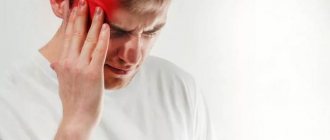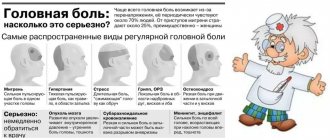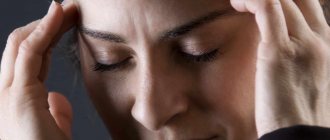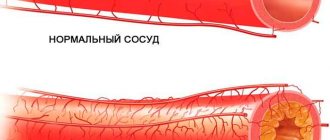Useful articles
Abuse or “rebound” headache is a pathology caused by the abuse of analgesics. It is the negative effect of drug treatment that is often detected in patients who complain of constant (daily) cephalgia. Treatment involves, first of all, stopping the uncontrolled use of painkillers and ergotamine.
Causes of overuse headaches
Overuse headache - otherwise it is called drug-induced, drug-induced, “rebound”.
It occurs in response to taking pharmacological drugs and is associated with tension headaches and migraines when the therapy for these syndromes is inadequately selected. Since potent medications are now quite accessible and are used without a medical prescription, cases are becoming more frequent when a primary headache is the basis of an abuse headache. Overuse headache is a chronic form of pain; in terms of its prevalence among the population, it is second only to migraines and tension headaches. About 1% of the adult population of the planet suffers from this form of headache; women are more often affected than men. Abuse pain reaches 60% among patients with chronic forms of headache. The cause of overuse headaches is the regular consumption of painkillers by patients with primary headaches. Most often this is a consequence of abuse of analgesics and combinations of analgesics with caffeine or codeine, sometimes triptans and ergotamines lead to the same effect. The reasons for increased pain are any physical or intellectual stress, as well as the withdrawal of medications after prolonged use. The latter forces patients to return to drug treatment.
Potentially dangerous medications include:
- combination analgesic drugs,
- ergotamine derivatives,
- opioids,
- specific drugs for relieving migraine attacks - serotonin receptor agonists (triptans),
- less often - non-steroidal anti-inflammatory drugs.
The risk of developing abuse is determined by both the quantity of one dosage and the regularity of their intake, but the latter is of greater significance. In other words, daily use of small doses of medication is more dangerous than loading doses, but from time to time. It is noted that alternating periods of frequent use of the drug with relatively long periods without treatment leads to the formation of MIGB much less often. To avoid the development of abuse, any headache analgesic drug should be discussed with a medical professional.
Overuse headaches are classified depending on the medication that provokes them:
- headache with excessive use of ergotamine,
- headache with excessive use of triptans,
- headache with excessive use of analgesics,
- headache with excessive use of opiates,
- headache with excessive use of combined analgesics,
- headache with excessive use of several classes of pain medications,
- headaches caused by excessive use of other medications.
Overuse headache is characterized by a variety of clinical manifestations in each individual case - these can include migraine-like manifestations and symptoms of tension headaches. In most cases, the clinical picture of abusive pain is as follows:
- daily dull pain throughout the head;
- squeezing or squeezing character;
- intensity is slight or moderate;
- the peak of pain occurs in the morning;
- additionally, fatigue, clouding of consciousness, decreased performance, irritability develop, and sleep disturbances are likely.
Patients with migraine, accompanied by constant dull pain, may experience attacks with symptoms similar to migraine several times a month:
- severe throbbing one-sided pain,
- with/without aura,
- nausea, vomiting,
- sensitivity to sounds and light
The role of factors in the chronicization of previously existing but episodic pain often turns out to be:
- emotional stress (depression, anxiety),
- the addition of another type of headache,
- tension of the pericranial muscles.
The functioning of the nociceptive systems of the brain is gradually disrupted:
- there is sensitization of peripheral and activation of “silent” nociceptors of the trigeminovascular system,
- hypersensitivity of neurons of the trigeminal nerve nucleus develops,
- as a consequence, there is a deficiency of descending inhibitory pathways.
This creates a “vicious circle” - an increase in the frequency of painful attacks leads to an increase in the use of painkillers, which in turn leads to daily and repeated use of drugs. Gradually used drugs have an increasingly weaker effect - pain relief occurs later, and it is clearly weaker. The disorder is aggravated by the presence of affective disorders - depression, anxiety.
Preventive measures and prognosis
With properly selected and persistent treatment, the patient can completely get rid of the disease and forget about debilitating headaches. But in approximately 30% of cases relapses occur. The patient must be warned about this so that he does not return to self-medication and strictly monitors the intake and dosage of the medications taken. Prevention consists of coordinating the use of any medications with a doctor. A neurologist will correctly assess the condition of the body and select treatment for primary pain. In addition, it is recommended:
- Reduce the amount of chocolate and caffeine-containing drinks (coffee, energy drinks, etc.);
- do not abuse alcohol, since hangover syndrome is most often relieved by analgesics and painkillers;
- avoid stress and conflict situations that can trigger migraines;
- monitor the amount of fluid consumed to prevent dehydration;
- Be in the fresh air a lot and often so that the brain receives a sufficient amount of oxygen.
In order to avoid a relapse, the patient must constantly monitor the intake of medications and record the dosage and name in a separate notebook. If your headaches return, you should immediately consult a doctor.
How to treat overuse headache?
Treatment of overuse headaches should be as early as possible, as soon as the doctor sees the relationship between the prescribed primary therapy and the developed consequences. Therefore, treatment of regular headaches should be carried out under the supervision of a professional physician with medications prescribed by him. The prognosis depends on the duration of drug abuse.
Not least important is the prevention of abusive headaches - this is an explanation of the risk of developing such headaches due to the abuse of painkillers in patients with a high frequency of attacks. Prevention is recognized by neurologists to be much more effective than subsequent therapy for developed abusive pain.
As part of the treatment of abuse pain, it is necessary, on the one hand, to explain to the patient that the treatment he is taking to get rid of migraine or tension pain turns out to be the cause of abuse pain, and on the other hand, it is important to convince the patient that discontinuation of the drug is the only way to relieve existing pain. There has been no drug treatment for abusive pain, which is based on inadequate medication use.
Main goals of patient management:
- discontinuation of the drug(s) that provoke abuse, detoxification if necessary;
- clarification of the nature of the primary form of headache (migraine or tension headache);
- prescription of preventive treatment depending on the initial form of cephalalgia;
- prevention of relapse.
Abrupt, immediate withdrawal of the drug is preferable. Within 48 hours after cancellation, you may experience:
- increased headache
- nausea or vomiting
- anxiety,
- sleep disorders.
Such symptoms may disappear after just a few hours, and sometimes take several weeks. Therefore, the withdrawal process should be planned in such a way that it does not have a noticeable impact on the patient's life (a 1-2 week sick leave may be required). If, despite discontinuation of the drug, headaches with symptoms of abuse persist, then in any case they become easier. Most patients, after 2 months of withdrawal, return to the original form of cephalalgia. Full recovery may take weeks or even months. To assess the dynamics of the pain syndrome, it is recommended to keep a headache diary to record symptoms and the number of medications taken.
Most patients with abuse headache, when discontinuing the drug, need to select a replacement drug to relieve the primary diagnosis. Usually, a drug from a different pharmacological group is recommended as a replacement (for example, if abuse in a patient with migraine was caused by a simple analgesic, triptans, ertogamin preparations, and others may be recommended to relieve attacks).
In parallel with drug withdrawal and detoxification, traditional preventive therapy is prescribed depending on the primary form of headache. It should be explained to the patient that the effect of preventive therapy will be insufficient if the drug that caused the abuse is not discontinued. The most effective drugs for the treatment of abusive headaches in patients with both migraine and tension headaches are antidepressants (amitriptyline, fluoxetine, escitalopram, duloxetine, milnacipran, venlafaxine) and anticonvulsants (topiramate, gabapentin, valproic acid preparations). Doses of anticonvulsants should be titrated to the recommended dose.
Relapses occur in 40% of patients over the next 5 years, so most patients require long-term follow-up. After successfully removing the abuse, it is important to explain to the patient the risk of the abuse returning and the need to strictly control the amount of pain medications. It is advisable to delay the return to taking the overuse drug as much as possible; it is preferable to switch to a drug from a different pharmacological group. If necessary, the painkiller can be taken again with caution after 2 months (the frequency of administration should not exceed 2 times a week).
Relevance of the disease
This pathology is characterized by extreme relevance, since it is approximately equally widespread in all economically developed countries in which it is possible to purchase various drugs with an analgesic effect over the counter.
Among patients with cephalgia visiting general practitioners, in terms of frequency, the pathology ranks third after migraine and tension headaches, which are typical primary forms of headaches. Among various other forms, abuse makes up 20%.
The prevalence of the abusive form in the population ranges from 1 to 4%, and among patients visiting specialized centers - 10%. Men (compared to women) get sick 3-5 times less often. Among all patients suffering from daily chronic headaches, the abusive form averages 60%.
Treatment of overuse headaches at home
Overuse headaches are usually treated at home. Carrying out detoxification measures may require the patient to be in a day hospital. At the same time, the withdrawal of drugs that caused abuse should be carried out under the strict supervision of the attending physician, and replacement therapy is prescribed by him. Self-medication is unacceptable. Usually, drug headaches are a consequence of self-medication and abuse of painkillers.
Diagnostics
To accurately diagnose an abusive type of headache, the patient needs to completely stop taking the medications that he used to relieve pain. Therefore, in most cases, diagnosing pathology is difficult. No instrumental or laboratory diagnostic methods can confirm or refute the presence of overuse syndrome. The main criteria that the doctor will look at when making a diagnosis include:
- After taking the pill, the pain intensifies.
- For several months, the patient takes a certain medicine.
- Cephalgia occurs at least 15 times within 1 month.
Algorithm for differential diagnosis of headaches
Additionally, the doctor may prescribe an examination of the brain and the condition of the blood vessels. For this use:
- Angiography.
- Dopplerography.
Read about how Doppler examination is carried out in a detailed article - /diagnostika/uzdg-sosudov-golovy-i-shei.html.
- Magnetic resonance imaging.
- Duplex scanning of blood vessels.
A neurologist treats abusive headaches.
What medications are used to treat overuse headache?
Although drug therapy cannot be used to treat abusive pain, to alleviate the withdrawal syndrome of the provoking drug, certain pharmacological agents are used, but from a completely different group of drugs. For example:
- flupirtine - on a regular basis at a dose of 100 mg 3 times a day during the first 3-4 weeks of the withdrawal period;
- topiramate - 25 mg/day once in the evening (for 1 week),
Detoxification treatment can be represented by the following schemes:
- in the morning dexamethasone 6-8 mg,
- magnesia 25% 10 ml,
- saline solution 100 ml (No. 7 droppers,
- amitriptyline 2 ml,
You should consult your doctor for details about the medication that is appropriate for your particular case.
Development mechanism
The abuse factor most often forms over a fairly long period of time. Pathogenesis directly depends on the psychological component, as well as on the type of pharmacological agent used. Most often, inadequate and unjustified use of medications begins with depression and increased anxiety. There is also a hereditary predisposition to the manifestation of abuse, depression, alcoholism, etc. The patient does not realize that long-term use of analgesics significantly reduces their effectiveness. This forces the patient to take medications more and more often, increase doses, and taking medications becomes a “way of life.” In this case, the pain is not completely relieved or the attack returns after a short period of time, which leads to the formation of pathological dependence. The fact that primary cephalalgia transforms into chronic is associated with the nociceptive system of the brain, which is responsible for pain perception.
Treatment of overuse headaches during pregnancy
Treatment of abuse headaches in pregnant women occurs according to the standard scheme, however, it is within the doctor’s competence to measure the toxicity of the prescribed drugs and prescribe exclusively the least dangerous ones for the woman and the developing fetus. If possible, during pregnancy, a woman will be advised to reduce, or even completely abandon, medications taken to relieve headache attacks. Any adjustments to previously prescribed treatment regimens are carried out by a neurologist during a face-to-face consultation.
I'll poison you, I'll poison you!
When your head is splitting, all your thoughts and desires are about one thing – to let it go as soon as possible! This torment is unbearable. It's good that there are painkillers. So the advertisement convinces: take the pill and the problem will instantly disappear! And it really disappears! True, then the pain occurs again and again. And now the hand automatically reaches for the pill. The person does not even suspect that he is gradually becoming hostage to a medicinal migraine. Now he’s already taking not one, but two pills, just to be sure. Then he swallows the medicine just in case, in case he suddenly gets sick, and there is an important meeting ahead. Further more. Spasms in the head begin to haunt a person every day. Somehow the same painkillers help you survive, although their effect is weaker and shorter every time. Finally, patients run to neurologists, suspecting the worst. This is definitely brain cancer, it seems to them, because the pain is already constant.
Headache? See a cardiologist! What does hypertension lead to Read more
Which doctors should you contact if you have a headache?
- Neurologist
- Family doctor
As with all headaches, diagnosis of abuse is based on the clinical picture of the disorder; usually the patient tells the doctor about previously observed symptoms - migraine or tension pain. If a patient with abusive pain was registered at the dispensary, then the development of new symptoms is analyzed through the prism of previously presented complaints. It is advisable to analyze the medical history and study pain therapy. Additional studies usually do not show functional abnormalities.
A headache diary is of particular importance in the case of overuse headaches. Management of this is also appropriate for primary pain, but it allows you to detect abuse at its early stage. The diary records the time of occurrence of the episodes, the number of drugs used, the intensity of the pain - analysis of the diary allows us to judge the development of the abuse.
Generalized diagnostic criteria for overuse headache:
- present for 15 days or more per month;
- regular abuse of one or more drugs for the relief of an acute attack and/or symptomatic treatment of headache for more than 3 months;
- pain occurs or worsens when taking an increased dose of medication;
- the pain stops or returns to the previous set of symptoms 2 months after stopping the medication identified as the cause of the abuse.
The diagnosis of abusive pain also requires clarification in its formulation, against the background of what headache it arose and under the influence of what medications.
Symptoms
The symptoms of the disease are related to the type of painful attacks and the medicine that a person takes to eliminate them. When taking triptans, the manifestations of primary cephalgia are neutralized immediately, but it returns and becomes stronger. Analgesics cause dull, aching pain that occurs with moderate strength.
Interesting: Why does your head hurt when you bend over?
Among the general signs of abuse are the following:
- increased outbreak of pain in the morning, after a night's sleep;
- severe pain in the back of the head and in the frontal area;
- pulsating sensation in the head;
- exacerbation as a result of physical and mental stress;
- irritability, short temper:
- absent-mindedness, loss of attention span;
- loss of performance;
- increased pain after stopping the drug.
Abuse disorder can be combined with migraine symptoms. At the same time, squeezing and squeezing are felt in the head. The person feels sick, vomits, has a painful reaction to light, and is intolerant of loud sounds.
Treatment of other diseases starting with the letter - a
| Treatment of lung abscess |
| Treatment of brain abscess |
| Treatment of liver abscess |
| Treatment of splenic abscess |
| Treatment of pituitary adenoma |
| Treatment of adnexitis |
| Treatment of acromegaly |
| Treatment of alcoholism |
| Treatment of alcoholic hepatitis |
| Treatment of alcoholic liver disease |
| Treatment of allergic dermatitis |
| Treatment of alopecia |
| Treatment of alveolitis |
| Treatment of amoebiasis |
| Treatment of liver amyloidosis |
| Treatment of renal amyloidosis |
| Treatment of sore throat |
| Treatment of aneurysm |
| Treatment of ankylosing spondylitis |
| Treatment of anuria |
| Treatment of kidney aplasia |
| Treatment of aplastic anemia |
| Treatment of ovarian apoplexy |
| Treatment of appendicitis |
| Treatment of arthrosis of the knee joint (gonarthrosis) |
| Treatment of ascariasis |
| Treatment of ascites |
| Treatment of pulmonary atelectasis |
| Treatment of atherosclerosis |
| Treatment of atypical pneumonia |
| Treatment of autoimmune hepatitis |
The information is for educational purposes only. Do not self-medicate; For all questions regarding the definition of the disease and methods of its treatment, consult your doctor. EUROLAB is not responsible for the consequences caused by the use of information posted on the portal.










